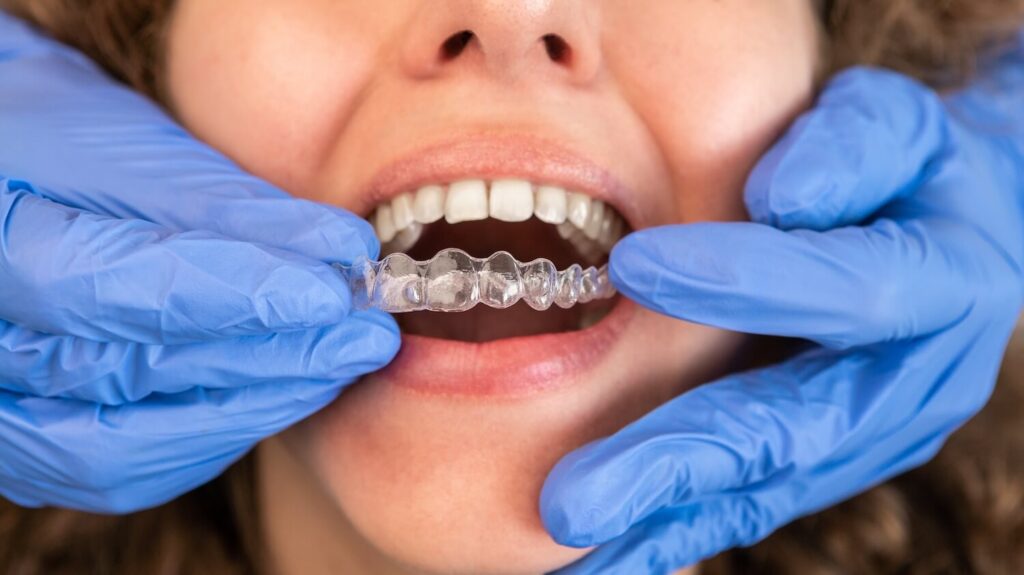In the pursuit of a perfect smile, one treatment option stands out for its blend of comfort, aesthetics, and effectiveness: Invisalign. Unlike traditional braces, Invisalign aligners are nearly invisible, offering a discreet way to correct various dental issues. Whether you’re looking to straighten your teeth, correct bite problems, or simply enhance your smile, Invisalign is becoming a go-to option for many people. But what should you expect when embarking on the Invisalign journey?
This comprehensive guide will walk you through the entire Invisalign process, from the first consultation to post-treatment care, giving you a clear understanding of what’s involved and how to prepare.
1. Initial Consultation: Setting the Invisalign Foundation
Your journey to a perfect smile with Invisalign begins with a consultation. During this first visit, you’ll meet with an orthodontist or dentist experienced in Invisalign treatment. The primary goal of this consultation is to determine whether Invisalign is the right choice for you.
Assessment of Dental Health
The orthodontist will conduct a thorough examination of your teeth and gums. They’ll take X-rays, photos, and digital scans or impressions of your teeth. This information helps the dentist create a 3D model of your mouth, which is essential for developing a treatment plan. They’ll also assess your specific dental issues, such as:
- Crooked teeth
- Overbite, underbite, or crossbite
- Gaps between teeth
- Crowding
Understanding Your Goals
In addition to assessing your dental health, your orthodontist will discuss your goals for treatment. Are you looking to enhance your smile for personal reasons, such as a wedding or job interview? Or are you motivated by health concerns, like improving your bite to avoid future dental issues? Understanding your motivations helps the orthodontist tailor the treatment plan to meet your needs effectively.
2. Personalized Treatment Plan: Crafting Your Invisalign Roadmap
If Invisalign is deemed suitable, your orthodontist will create a personalized treatment plan. Using the 3D model of your teeth, they’ll map out the gradual movements your teeth will make over time. The plan will include:
- The estimated length of your treatment (typically between 6 to 18 months)
- The number of aligners you’ll need (ranging from 20 to 30 aligners for many patients)
- Predicted milestones (e.g., when major shifts will happen)
Advanced Technology and Simulation
One of the significant advantages of Invisalign is the use of advanced technology to visualize the treatment process. Your orthodontist may use software to create a digital simulation of your expected results. This gives you a preview of what your smile will look like at the end of treatment, providing motivation to stay on track.
Financial Considerations
During this consultation, your orthodontist will also discuss the financial aspects of your treatment. The cost of Invisalign can vary widely based on factors such as the complexity of your case and your geographical location. Many dental practices offer flexible payment plans, financing options, or even partnerships with third-party companies to help make treatment more accessible.
3. The Aligners: Crafting Your Custom Smile
Invisalign aligners are custom-made using advanced technology based on the impressions or scans taken during your consultation. Each set of aligners is designed to apply gentle pressure on specific teeth, gradually shifting them into place over time.
Materials and Comfort
Invisalign aligners are made from a smooth, BPA-free plastic that won’t irritate your gums or cheeks, a common issue with traditional braces. The aligners are thin, clear, and fit snugly over your teeth, making them barely noticeable to others. You’ll need to wear your aligners for 20 to 22 hours each day for the treatment to be effective.
Aligners Delivery
Once your aligners are ready, you’ll receive a series of them to start the treatment. Your orthodontist will show you how to properly wear and care for the aligners. You’ll typically switch to a new set of aligners every one to two weeks, with each set bringing you closer to your desired result.
4. Wearing Your Aligners: What to Expect Day-to-Day
Once you begin wearing the aligners, your daily routine will change slightly. Here’s what you can expect as you start your treatment:
Adjusting to Invisalign
At first, you might feel some pressure or discomfort, especially when switching to a new set of aligners. This is completely normal and a sign that your teeth are moving. The discomfort typically subsides within a day or two. You may also notice a slight lisp when speaking, but this usually goes away as you get used to wearing the aligners.
Eating and Drinking
One of the main advantages of Invisalign over traditional braces is that the aligners are removable. You won’t have to worry about food restrictions. However, you must remove the aligners before eating or drinking anything other than water. After eating, brush your teeth before putting the aligners back in to avoid trapping food particles, which could lead to cavities or bad breath.
Oral Hygiene Routine
Maintaining good oral hygiene is crucial during Invisalign treatment. You’ll need to brush and floss after every meal to ensure your teeth and aligners stay clean. Cleaning the aligners themselves is also important. You can use Invisalign cleaning crystals or simply brush them gently with a toothbrush and rinse them with lukewarm water.
Keeping Track of Your Aligners
To ensure your treatment stays on track, consider creating a system to help you remember when to switch aligners and when to wear them. Some patients find it helpful to set reminders on their phones or use a journal to track their progress. Staying organized can help minimize the chances of misplacing an aligner or forgetting to wear them.
5. Monitoring Progress: Regular Check-ins
Throughout your Invisalign treatment, you’ll have regular check-ins with your orthodontist. These appointments typically happen every four to six weeks and are important for:
- Ensuring your teeth are moving as planned
- Addressing any issues, such as aligners not fitting properly
- Adjusting the treatment plan if necessary
Your orthodontist will also give you your next sets of aligners during these appointments. In some cases, small tooth-colored attachments may be placed on your teeth to help the aligners apply the right amount of pressure in certain areas.
6. Mid-Treatment: Tracking Changes and Making Adjustments
Around the halfway point of your treatment, you’ll likely start noticing significant changes in the alignment of your teeth. The improvements will become more visible, which can be a great motivator to stay consistent with wearing your aligners.
Temporary Attachments
To assist with difficult tooth movements, your orthodontist may apply tiny, tooth-colored “attachments” to certain teeth. These attachments help the aligners get a better grip on the teeth, making it easier to achieve more complex movements. Don’t worry, these attachments are discreet and temporary.
Rubber Bands for Bite Issues
If you’re addressing bite problems (such as an overbite or underbite), your orthodontist may incorporate rubber bands into your treatment. These rubber bands are attached to your aligners and help improve your bite by shifting the position of your jaw over time. It’s important to wear these as directed, as they play a crucial role in achieving your desired bite.
Lifestyle Adjustments
While wearing aligners is relatively straightforward, you may need to make some minor lifestyle adjustments. For example, if you’re an athlete, wearing a mouthguard while playing contact sports can be more challenging. However, many athletes continue their training with minimal disruption by ensuring they wear their aligners only during games and practices when needed.
7. End of Treatment: The Final Stretch
As you approach the end of your Invisalign journey, the excitement of seeing your perfect smile will grow. Once you’ve gone through your prescribed sets of aligners, your orthodontist will evaluate your teeth to ensure they have moved into their ideal positions.
Refinements and Final Adjustments
In some cases, patients may require refinement trays to make small adjustments after completing their initial series of aligners. These refinement trays are additional aligners created to fine-tune your smile to perfection. While not always necessary, they can help ensure the final result matches your treatment goals.
Removal of Attachments
If attachments were used during your treatment, they will be removed at this stage. The process is quick and painless, and you’ll immediately see how much your smile has improved.
8. Post-Treatment: Retainers and Long-Term Care
After finishing your Invisalign treatment, the next step is to ensure your teeth remain in their new positions. This is where retainers come into play.
Retainers: Maintaining Your New Smile
Your orthodontist will create a custom retainer for you, usually made from a clear plastic material similar to the Invisalign aligners. Retainers are essential for preventing your teeth from shifting back to their original positions. In the beginning, you’ll need to wear the retainer full-time (except while eating) for a few months, eventually transitioning to wearing it only at night.
Long-Term Care
To maintain your beautiful new smile, it’s important to continue practicing good oral hygiene and attending regular dental check-ups. Wearing your retainer as directed will prevent your teeth from shifting over time, allowing you to enjoy your perfect smile for years to come.
9. Lifestyle Considerations: Embracing Your New Smile
As you transition from active treatment to post-treatment care, it’s essential to embrace your new smile fully. Many patients find that their newfound confidence influences various aspects of their lives, including social interactions, job prospects, and even their overall well-being.
Sharing Your Experience
Consider sharing your Invisalign journey with friends and family. You might find that others are curious about your experience and even interested in pursuing their orthodontic treatments. Your success can inspire others to take the first steps toward achieving their ideal smiles.
Documenting Your Progress
Take photos throughout your treatment to document your progress. Not only will this serve as a beautiful reminder of your journey, but it can also help you appreciate the changes over time.
Conclusion
Invisalign offers a modern, effective approach to achieving a beautiful smile. While the journey requires commitment and diligence, the results can be life-changing. By understanding what to expect at each stage of the treatment process, you can prepare yourself for a smoother experience and ultimately enjoy the confidence that comes with a perfect smile. If you’re considering Invisalign, don’t hesitate to consult with a qualified orthodontist to learn more about how this innovative treatment can work for you.


